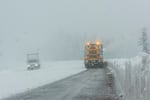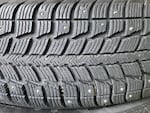Over the past 10 years, excluding 2020, the month of December has seen the highest number of car crashes, according to the Oregon Department of Transportation. Traveling in winter conditions can be daunting and dangerous, but preparing early can reduce your risks of crashing or getting stuck in snow.

FILE: A snowplow clears a path on Highway 26 near Government Camp, Oregon, in this Jan. 9, 2024 photo.
Courtesy of ODOT
ODOT has many resources on driving preparation in winter, including travel information website TripCheck. The site is equipped with updated maps and camera footage of road conditions, travel times and links to alternative travel options. Travelers in Oregon can call 511 to access the same road and weather information on the phone.
Checking these and other resources before traveling can help you stay informed on what you’ll need to handle the conditions.
One of the best ways to adapt your vehicle to winter conditions is by keeping chains in your car or using traction tires. ODOT has tips on driving with both.
Tips on chaining up and driving with chains
- Check your vehicle operator’s manual for the right type and size of chains to use. Follow the manufacturer’s installation instructions.
- Ensure chains are the proper size. Don’t deflate tires to install chains.
- Pull over to a safe and level area to mount or remove chains.
- Pull over in a safe place and retighten your tire chains after you have driven a short distance.
- Pull over and stop immediately if any part of your chain fails or comes loose.
- Don’t drive faster than 30 miles per hour when using chains. Accelerate and decelerate slowly. Avoid spinning or locking your wheels.
- For vehicles that cannot be fitted with tire chains, a potential option is one of the fabric cover products that slip over your tires. These are only intended for short stretches of road in adverse conditions.
More information on Oregon’s chain law and chain requirements.
Traction Tires

Studded tires are made to help drivers in icy and snowy conditions, but they are only allowed on the road during certain times of the year.
Francisca Benitez / OPB
Studded tires
- Studded tires are more effective than all-weather tires on icy roads, but are less effective in most other conditions because they may reduce traction between the road and the tire.
- You can only use studded tires in Oregon from Nov. 1 to March 31.
Other traction tires
- Traction tires other than studded tires provide increased traction in winter conditions.
- They work about as well as studded tires on ice, but work better than studded tires or regular tires in most other winter conditions.
- These traction tires cause no more damage to road surfaces than regular tires.
During the winter season, some roads require chains or traction tires. Look out for signs on the road that indicate snow zones or required chains.
In some cases, road conditions that might not require chains or traction tires are still hazardous for drivers. Bridges and overpasses tend to freeze over quicker than roads, and can be an overlooked danger when driving in the winter.
Allowing extra stopping distance from the vehicle in front of you and driving more slowly can make a big difference. ODOT has tips on how to drive cautiously on snow or ice.
Tips for driving in the snow
- Brake gently to avoid skidding or sliding. If the wheels lock up, ease off the brakes.
- Make sure your vehicle is in top operating conditions, with clean headlights, good brakes, working windshield wipers and good tires.
- Slow down when approaching off-ramps, bridges and shady spots where the snow often lingers longer.
- Turn on your headlights to increase your visibility.
- Be prepared for delays. Make sure you have water, blankets and a full tank of gas. Don’t be afraid to stop for the night.
Tips for driving on ice
- Turn off your cruise control, be alert and drive cautiously.
- Roads that are wet or have fresh snow, packed snow, or ice have varying degrees of traction. Adjust your speed to match road conditions accordingly.
- If your vehicle suddenly feels like it’s floating, gradually slow down. Tap on your brakes gently, but don’t slam on them.
- Changes in elevation can drastically affect road and weather conditions. Watch for icy spots, especially in shaded corners.
- Look for signs of ice on windshield wipers, side view mirrors, road signs, trees or fences. If ice has formed on any of these things, it may be on the road as well.
ODOT has many other resources for driving in winter conditions, including a winter driving guide and more tips for driving, cycling or walking in winter.
